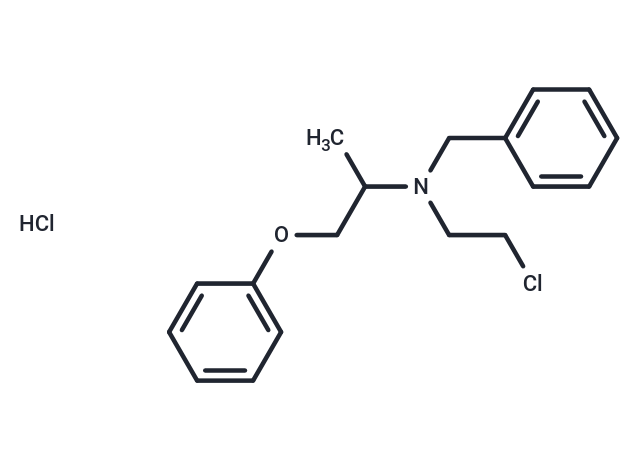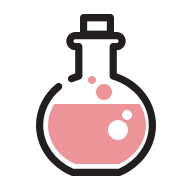- Remove All
 Your shopping cart is currently empty
Your shopping cart is currently empty
Shopping Cart
Phenoxybenzamine hydrochloride
Catalog No. T1158Cas No. 63-92-3
Alias Phenoxybenzamine HCl, NSC 37448, NCI-c01661
Phenoxybenzamine hydrochloride (NCI-c01661) is the hydrochloride salt form of phenoxybenzamine, a synthetic, dibenzamine alpha-adrenergic antagonist with antihypertensive and vasodilatory properties. Phenoxybenzamine non-selectively and irreversibly blocks the postsynaptic alpha-adrenergic receptor in smooth muscle, thereby preventing vasoconstriction, relieving vasospasms, and decreasing peripheral resistance. Reflex tachycardia may occur and may be enhanced by blockade of alpha-2 receptors which enhances norepinephrine release. Phenoxybenzamine is reasonably anticipated to be a human carcinogen.

Phenoxybenzamine hydrochloride
Catalog No. T1158Alias Phenoxybenzamine HCl, NSC 37448, NCI-c01661Cas No. 63-92-3
Phenoxybenzamine hydrochloride (NCI-c01661) is the hydrochloride salt form of phenoxybenzamine, a synthetic, dibenzamine alpha-adrenergic antagonist with antihypertensive and vasodilatory properties. Phenoxybenzamine non-selectively and irreversibly blocks the postsynaptic alpha-adrenergic receptor in smooth muscle, thereby preventing vasoconstriction, relieving vasospasms, and decreasing peripheral resistance. Reflex tachycardia may occur and may be enhanced by blockade of alpha-2 receptors which enhances norepinephrine release. Phenoxybenzamine is reasonably anticipated to be a human carcinogen.
| Pack Size | Price | Availability | Quantity |
|---|---|---|---|
| 500 mg | $29 | In Stock | |
| 1 g | $42 | In Stock | |
| 1 mL x 10 mM (in DMSO) | $29 | In Stock |
Bulk & Custom
Add to Cart
Questions
View MoreSelect Batch
Purity:100%
Contact us for more batch information
All TargetMol products are for research purposes only and cannot be used for human consumption. We do not provide products or services to individuals. Please comply with the intended use and do not use TargetMol products for any other purpose.Product Introduction
Bioactivity
Chemical Properties
| Description | Phenoxybenzamine hydrochloride (NCI-c01661) is the hydrochloride salt form of phenoxybenzamine, a synthetic, dibenzamine alpha-adrenergic antagonist with antihypertensive and vasodilatory properties. Phenoxybenzamine non-selectively and irreversibly blocks the postsynaptic alpha-adrenergic receptor in smooth muscle, thereby preventing vasoconstriction, relieving vasospasms, and decreasing peripheral resistance. Reflex tachycardia may occur and may be enhanced by blockade of alpha-2 receptors which enhances norepinephrine release. Phenoxybenzamine is reasonably anticipated to be a human carcinogen. |
| In vitro | The IC50 (100 nM) derived from the blockade of [3H]yohimbine binding by Phenoxybenzamine hydrochloride is significantly less than the IC50 (550 nM) for the corresponding reversal by Phenoxybenzamine hydrochloride of the effects of norepinephrine on cyclic AMP accumulation[1]. Phenoxybenzamine hydrochloride (50 nM) in conbination with Phenoxybenzamine hydrochloridetolamine (1000 nM) enhances Phenoxybenzamine hydrochlorideylephrine-induced contraction compared with pretreatment with Phenoxybenzamine hydrochloride (50 nM) alone in endothelium-intact aortae. Combined treatment with either dexmedetomidine (300 or 1000 nM) and Phenoxybenzamine hydrochloride (50 nM) or Phenoxybenzamine hydrochloridetolamine (1000 nM) and Phenoxybenzamine hydrochloride (50 nM) enhance Phenoxybenzamine hydrochlorideylephrine-induced contraction compared with Phenoxybenzamine hydrochloride alone (50 nM). In addition, combined treatment with Phenoxybenzamine hydrochloridetolamine and Phenoxybenzamine hydrochloride enhances Phenoxybenzamine hydrochlorideylephrine-induced contraction compared with dexmedetomidine (1000 nM) and Phenoxybenzamine hydrochloride combined treatment. Combined treatment with high concentrations of dexmedetomidine (1000 nM) and Phenoxybenzamine hydrochloride enhances Phenoxybenzamine hydrochlorideylephrine-induced contraction compared with combined treatment with low concentrations of dexmedetomidine (300 nM) and Phenoxybenzamine hydrochloride[2]. |
| In vivo | Phenoxybenzamine hydrochloride (20 nM, s.c.) effectively suppresses the tumorigenesis of glioma cells in mice and the cell density in Phenoxybenzamine hydrochloride-U87 mg xenografts decreases significantly[3]. Phenoxybenzamine hydrochloride (1 mg/kg, i.v.) treated rats shows significant improvements in NSS and foot fault scoring[4]. |
| Cell Research | Phenoxybenzamine hydrochloride is dissolved in DMSO. After cytometry, 1×3 cells are implanted in a 96-well plate in 100 μL DMEM supplemented with 10 % FBS. Ten microliter (10 % of the total volume) WST-1 (Water Soluble Tetrazolium) is added to cells and incubated at 37°C for 30 min before colorimetric assay with 450 nm excitation and 630 nm emission at 24 h intervals up to 96 h. The mean fluorescence value is counted, and the cell number is determined using the standard curve. |
| Alias | Phenoxybenzamine HCl, NSC 37448, NCI-c01661 |
| Molecular Weight | 340.3 |
| Formula | C18H23Cl2NO |
| Cas No. | 63-92-3 |
| Smiles | Cl.CC(COc1ccccc1)N(CCCl)Cc1ccccc1 |
| Relative Density. | no data available |
Storage & Solubility Information
| Storage | Powder: -20°C for 3 years | In solvent: -80°C for 1 year | Shipping with blue ice. | ||||||||||||||||||||||||||||||||||||||||
| Solubility Information | Ethanol: 63 mg/mL (185.13 mM), Sonication is recommended. H2O: 14 mg/mL (41.14 mM), Sonication is recommended. DMSO: 55 mg/mL (161.62 mM), Sonication is recommended. | ||||||||||||||||||||||||||||||||||||||||
Solution Preparation Table | |||||||||||||||||||||||||||||||||||||||||
H2O/DMSO/Ethanol
DMSO/Ethanol
| |||||||||||||||||||||||||||||||||||||||||
Calculator
In Vivo Formulation Calculator (Clear solution)
Please enter your animal experiment information in the following box and click Calculate to obtain the mother liquor preparation method and in vivo formula preparation method:
Mother liquor preparation method: 2 mg of drug dissolved in 50 μL DMSO (mother liquor concentration of 40 mg/mL), if you need to configure a concentration that exceeds the solubility of the product, please contact us first.
(mother liquor concentration of 40 mg/mL), if you need to configure a concentration that exceeds the solubility of the product, please contact us first.
Preparation method for in vivo formula: Take 50 μL DMSO main solution, add 300 μLPEG300
main solution, add 300 μLPEG300 mix well and clarify, then add 50 more μL Tween 80, mix well and clarify, then add 600 more μLddH2O
mix well and clarify, then add 50 more μL Tween 80, mix well and clarify, then add 600 more μLddH2O mix well and clarify
mix well and clarify
For Reference Only. Please develop an appropriate dissolution method based on your laboratory animals and route of administration.
Dose Conversion
You can also refer to dose conversion for different animals. More Dose Conversion
Tech Support
Please see Inhibitor Handling Instructions for more frequently ask questions. Topics include: how to prepare stock solutions, how to store products, and cautions on cell-based assays & animal experiments, etc
Keywords
Related Tags: buy Phenoxybenzamine hydrochloride | purchase Phenoxybenzamine hydrochloride | Phenoxybenzamine hydrochloride cost | order Phenoxybenzamine hydrochloride | Phenoxybenzamine hydrochloride chemical structure | Phenoxybenzamine hydrochloride in vivo | Phenoxybenzamine hydrochloride in vitro | Phenoxybenzamine hydrochloride formula | Phenoxybenzamine hydrochloride molecular weight

Copyright © 2015-2025 TargetMol Chemicals Inc. All Rights Reserved.



